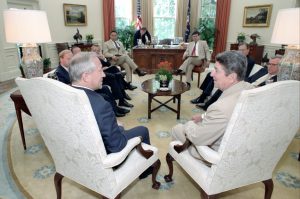Last week marked the 34th anniversary of one of the most alarming moments of the Cold War. In November 1983, NATO allies engaged in a routine communication post-war game referred to as Able Archer 83. However, events leading up to Able Archer led the Soviet Union to believe that NATO was merely using the exercise as a means to initiate nuclear war.
The Able Archer game was a test of NATO allies’ communication capabilities, in case of rapid escalation from the Soviet Union. The game followed a script that began with a diplomatic dispute between East and West Germany, leading to a full invasion of West Germany, Norway, and Greece by Soviet forces. As the game progressed, the scenario would advance from invasion to the use of chemical weapons by Moscow, prompting a NATO nuclear response.
These games were in no way secret. In fact, the Soviet Union had been notified of the exercise, and it was understood that the Soviets would be intercepting the communications, so each relevant message sent between NATO bases had “exercise” written into them. Nonetheless, Soviet paranoia continued.
U.S. actions also compounded the situation. The United States was in the process of deploying Pershing II nuclear-capable missiles in Europe that could reach Moscow in six to eight minutes. Along with the Pershing II deployment, President Reagan had recently proposed the Strategic Defense Initiative (SDI), commonly known as Star Wars. SDI was a hypothetical missile defense shield that was both technologically infeasible and colossally expensive, but Kremlin leaders saw it as a sign that the United States was preparing a nuclear strike against them. Their thinking was simple: the United States would strike the Soviet Union and then use their missile defenses to prevent them from striking back. Moreover, in response to the Oct. 23, 1983 bombing of a Marine base in Beirut, the U.S. military increased security and alert levels at bases, prompting some Soviet planners to believe that the United States was preparing for war.
Soviet actions made the situation even more tense. On Sept. 1, 1983 a Soviet fighter plane shot down what was believed to be an American spy plane in Soviet airspace. In fact, the downed plane was a commuter aircraft flying from Anchorage, Alaska to Seoul. More than 250 civilian passengers died, including a sitting U.S. Member of Congress. Kremlin officials feared that Washington could use this event as justification for a potential strike.
The situation hit its climax when Soviet leader Yuri Andropov was notified of a NATO request for nuclear strikes on 25 Soviet targets. When these communications were intercepted and decoded, the Soviet military was placed on the highest alert level and were instructed to be ready for action. Tanks were deployed, jets were ready for takeoff, and submarines poised to launch return missiles. After 24 hours of waiting for a “go” signal, the military was taken off of high alert once the Able Archer exercise ended — and it was made clear that no American nuclear missiles had been, or would be, launched.
Shockingly, all of this occurred with little to no U.S. knowledge. The United States kept tabs on Soviet military preparations, but it was not uncommon for their troops to be ordered on high alert for drills. The full extent of the military preparedness and the reason behind it was only discovered by the Reagan Administration much later.
The entire Able Archer 83 episode revealed a major gap in U.S. intelligence and highlighted a severe lack of emergency communication between the Cold War foes. President Reagan was struck by the situation, and it was one of many events that inspired him to forge better relations with Moscow.
Today, U.S.–Russia relations are at their lowest point since the Cold War. The events of Able Archer 83 should serve as a useful reminder to policymakers in Washington and Moscow that, no matter how bad the situation gets, diplomacy and open communication must always be on the table.

